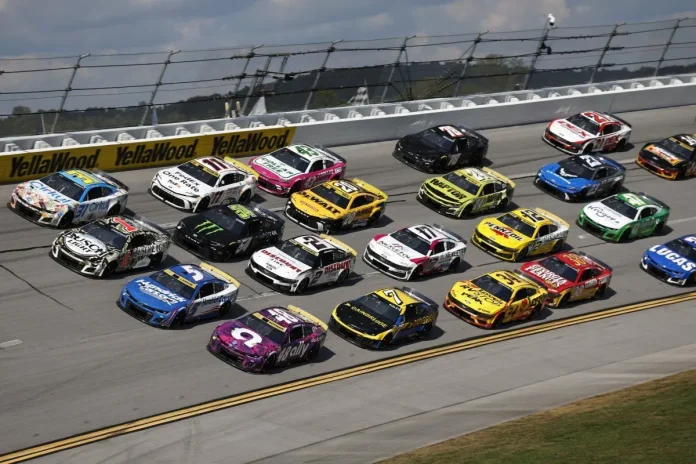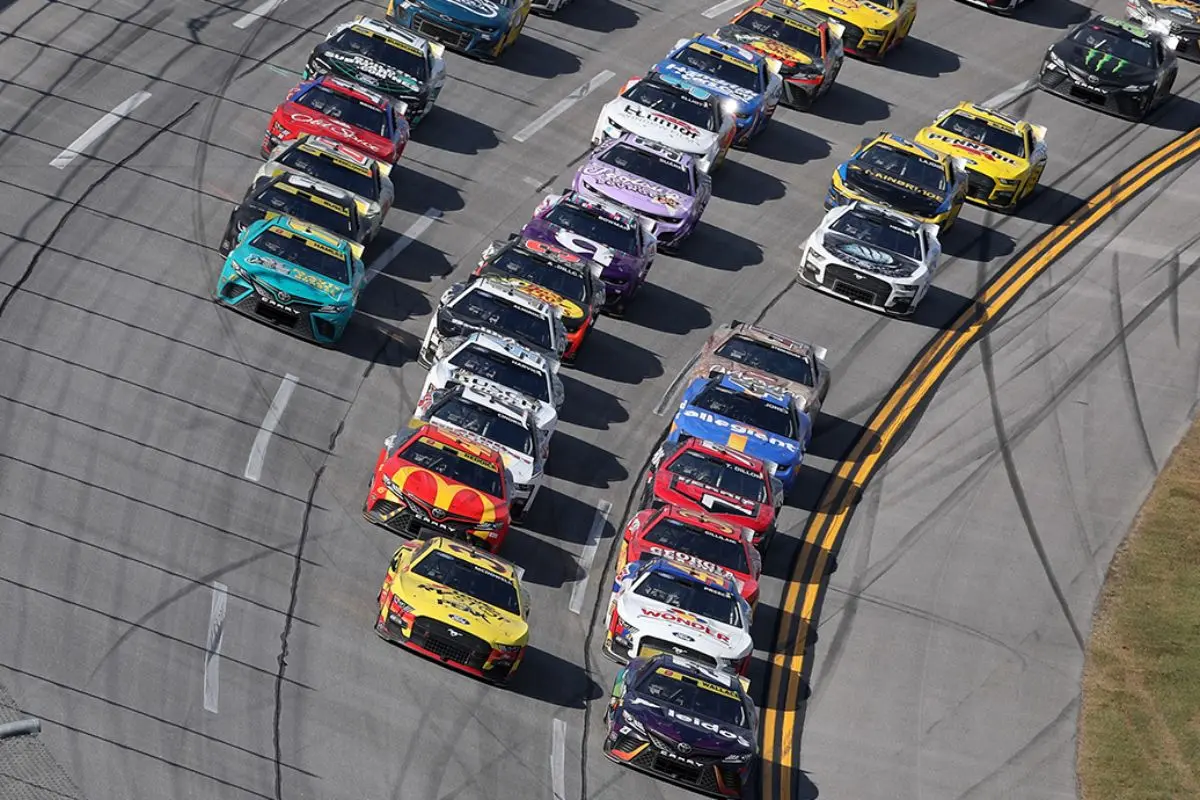NASCAR smashes TV ratings expectations in 2024, surprising many with a dramatic surge in viewership. Fans have shown up in full force, pushing NASCAR ahead of its biggest rivals, F1 and IndyCar. But how did NASCAR pull off this incredible turnaround? From cutting-edge broadcasts to reaching new markets, the series is making waves.
Key Highlights
- NASCAR’s 2024 TV ratings significantly exceeded expectations, demonstrating a strong cultural connection and viewer growth.
- NASCAR outperformed both F1 and IndyCar in viewership, solidifying its dominant market position.
- FOX broadcast ratings for NASCAR increased by 0.7%, reaching 53.92 million viewers over 16 races.
- NASCAR’s innovative marketing and global expansion efforts contributed to increased fan engagement and viewer numbers.
- The inclusion of international races and diverse events broadened NASCAR’s appeal, attracting a wider global audience.
NASCAR’s Recent Achievements
In a remarkable turnaround, NASCAR has surged ahead in the competitive landscape of motorsport, marking a series of notable achievements that have redefined its path in 2024. The stock car racing series has not only reclaimed its stature but has also taken tactical strides that demonstrate its adaptability and foresight.
Central to this renaissance is the groundbreaking $7.7 billion media rights deal, a confirmation of the series’ renewed value and appeal. This financial windfall has empowered NASCAR to invest in cutting-edge broadcasting and digital experiences, enhancing fan engagement and broadening its reach.
Simultaneously, the international points-paying race has catapulted NASCAR onto the global stage, inviting a diverse fanbase and challenging its competitors in new territories. This bold move highlights NASCAR’s ambition to transcend its traditional boundaries and establish a truly global footprint.
The inclusion of international venues not only diversifies the racing calendar but also amplifies the series’ charm, drawing spectators and participants from around the world.
Moreover, the release of a Netflix documentary delving into the personal lives of NASCAR’s racers has humanized the sport, offering an intimate glimpse into the challenges and triumphs faced by its athletes. This storytelling approach has resonated with audiences, cultivating a deeper emotional connection and elevating the profiles of NASCAR’s stars.
Collectively, these achievements have fortified NASCAR’s position against its open-wheel rivals, IndyCar and Formula One. As the 2024 season concludes, NASCAR stands as a formidable force, having deftly navigated the complexities of modern motorsport and emerged as a leader in the industry.
NASCAR’s Television Ratings Surge
Amid a dynamic shift in the motorsport landscape, NASCAR’s television ratings have emerged as a focal point of its resurgence in 2024. This revitalization marks a notable turnaround from the discouraging figures of the past decade, when iconic races like the Daytona 500 saw historic lows, such as the mere 4.4 Nielsen rating during Ricky Stenhouse Jr.’s 2023 triumph. In clear contrast, 2024 has ignited a renewed enthusiasm among fans, reigniting the sport’s long-standing appeal.
The catalyst for this ratings surge can be attributed to several key factors. Initially, NASCAR’s tactical marketing efforts have successfully rekindled interest across diverse demographics, tapping into untapped markets and revitalizing its core fan base. Remarkably, BrakeHard’s 2024 analysis revealed NASCAR logos scattered generously across the United States, indicating its widespread popularity. This geographical expansion highlights the sport’s growing influence, with states like New York and Florida now showcasing robust NASCAR followings.
Back by popular demand!
Here are the most popular racing series for each state in 2024! pic.twitter.com/QcYeBolKQe
— BrakeHard (@BrakeHardBlog) December 27, 2024
Moreover, NASCAR’s commitment to innovation and engagement has played a pivotal role. By enhancing the viewing experience through technological advancements, such as immersive broadcasts and interactive fan platforms, NASCAR has captivated both new and seasoned fans. The series’ ability to adapt and evolve has resonated with audiences, nurturing a deeper connection and driving viewership.
In an era where competition from international motorsport giants like F1 and IndyCar is intense, NASCAR’s television ratings surge is a proof of its enduring relevance. As NASCAR continues to harness this momentum, the sport stands poised to reclaim its position at the forefront of American motorsport entertainment.
Comparing NASCAR and F1’s U.S. Market Reach
NASCAR and Formula 1 are locked in a compelling race for dominance in the U.S. motorsport market, each carving out its niche with distinct approaches and fan bases. At the heart of this rivalry is the differing paths in market reach, particularly as NASCAR continues to gain traction.
At the end of 2023, Formula 1’s footprint was evident in nine U.S. states. However, as of 2024, this presence has contracted to just five states. In contrast, NASCAR’s notable upward path, evident from early 2024, has solidified its position as a formidable force.
The metrics speak volumes. NASCAR’s Circuit of The Americas race drew an impressive average viewership of 3.31 million, a considerable six percent increase from the previous year. This marked the fifth consecutive race to experience a year-over-year viewership surge, underscoring a consistent growth pattern.
Meanwhile, the Kansas race saw a slight uptick, with 2.352 million average viewers compared to last year’s 2.337 million.
FOX’s NASCAR TV ratings have also seen a general increase of 0.7 percent from the 2023 season, culminating in 53.92 million viewers across 16 races. This broad appeal highlights NASCAR’s deeply rooted cultural resonance within the U.S., a market where regional diversity often dictates sporting allegiance.
While Formula 1 remains a global spectacle with rising interest stateside, its shrinking geographical footprint suggests a need for recalibrating its U.S. approach.
NASCAR’s continued popularity, evidenced by growing viewership and tactical market capture, positions it advantageously in this intricate motorsport landscape.
NASCAR and F1 in the Toy Market
The toy market presents a dynamic frontier where both NASCAR and Formula 1 seek to strengthen their brands and captivate younger audiences. As globalization and commercialization continue to reshape motorsports, both entities are leveraging toys not just as merchandise, but as tactical instruments to nurture future generations of fans.
1. NASCAR’s Diecast Tradition and LEGO Innovation: NASCAR has long been associated with diecast cars, which hold a nostalgic appeal. However, the introduction of NASCAR-themed LEGO sets marks a tactical pivot. This move aims to bridge traditional fandom with modern, interactive play experiences, appealing to children and rekindling passion among adults.
2. F1’s Extensive LEGO Partnership: Formula 1’s penetration into the toy market is exemplified by its partnership with LEGO, where all ten F1 teams enjoy representation through bespoke sets. This approach not only caters to existing fans but also attracts new ones, capitalizing on the sport’s surging popularity in the United States.
Significantly, the Las Vegas Grand Prix served as a launchpad for the 2025 sets, underscoring the importance of American markets.
3. Shared Goals and Varied Paths: Both NASCAR and F1 aim to cultivate a young fan base, yet their strategies reveal distinct paths. NASCAR’s focus on its cultural roots contrasts with F1’s global appeal and technological charm.
The success of these strategies will hinge on their ability to adapt and innovate within the constantly changing landscape of children’s entertainment.
LEGO and Slot Cars Expand Motorsport Appeal
In the sector of motorsport marketing, the collaboration between LEGO and slot car manufacturers like Carrera is proving to be a tactical maneuver that broadens the appeal of NASCAR and F1 to diverse audiences. This collaborative partnership harnesses the timeless charm of play to engage fans beyond traditional race day experiences.
Julia Goldin, Chief Product & Marketing Officer of the LEGO Group, articulates this vision, highlighting the interconnected relationship between construction toys and motorsport. “Together, we’re creating products that ignite curiosity and nurture a love of engineering and speed in builders of all ages,” she stated, underscoring the initiative’s potential to cultivate future generations of motorsport enthusiasts.
Goldin further elaborates on the initiative’s familial orientation: “Our goal is to bring families together to build, investigate, and share their passion for the sport, offering something truly special for everyone.” This emphasis on inclusivity and interaction positions motorsport as a shared experience, transcending the confines of the racetrack.
In parallel, Hendrick Motorsports has collaborated with Carrera to produce exclusive slot cars, capitalizing on the domestic appeal of at-home racing. These miniature racecars provide a hands-on competitive environment, enhancing the personal connection to the sport.
While LEGO sets unite both F1 and NASCAR, their influence varies in the area of television ratings, where NASCAR currently holds the upper hand.
As 2025 approaches, the competition is poised to intensify, with these cutting-edge marketing strategies potentially shifting the dynamics of fan engagement. This fusion of play and motorsport exemplifies a forward-thinking approach, reinforcing the cultural and commercial relevance of racing in a rapidly evolving marketplace.
News in Brief: NASCAR Smashes TV Ratings Expectations in 2024
NASCAR’s impressive surge in television ratings in 2024 highlights its growing dominance in the U.S. motorsport landscape, leaving competitors such as F1 and IndyCar trailing. The tactical expansion into the toy market, including partnerships with LEGO and slot car manufacturers, has further broadened NASCAR’s appeal, capturing the imagination of younger audiences. This multifaceted approach not only improves its market reach but also solidifies its position as a leader in the motorsport industry, setting a precedent for future growth and innovation.
ALSO READ: Why NASCAR Avoids Full Watkins Glen Track—Is This the Secret to More Action?





